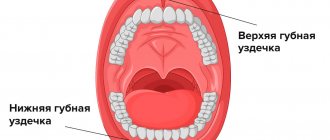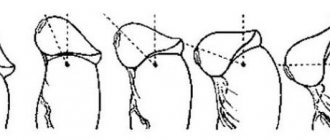When is tongue frenulum trimming required?
The frenulum of the tongue is a small elastic membrane connecting the tongue to the oral cavity. The frenulum is responsible for important functions of the tongue: movement, breathing, swallowing, speech. This disorder is called ankylogloxia.
The normal development of the lingual frenulum begins centrally, at the root of the tongue, and ends at the lower incisors. The rest of the arrangement is a deviation. There are several deviations in the development of the frenulum:
- Short bridle. The tongue becomes inactive and leads to improperly formed speech and jaw deformation.
- Incorrectly positioned frenulum. Reduces motor activity of the tongue.
- Long frenulum under the tongue. It can be located at the tip of the tongue and affect the swallowing process, disrupting nutrition.
Problems with the development of the tongue frenulum are a congenital pathology. And it is hereditary in nature. May occur due to problems during pregnancy.
Trimming the frenulum for an adult
The operation to trim the frenulum of the tongue can be performed at any age as prescribed by a doctor.
Every 20th person has a shortened frenulum of the tongue. The likelihood of this anomaly occurring in men is much higher than in women.
To independently check how the frenulum is located under the tongue, you can do simple children’s exercises: “horse”, “mushroom”, “painter”. Externally, the frenulum will not differ from a healthy state. If you experience any discomfort while performing these exercises, you should go to the clinic for a consultation.
Symptoms that will help you identify problems with tongue webbing:
- When the tongue is extended, the tip of the tongue bends down;
- Difficulty swallowing;
- It is not possible to insert the tongue completely;
- Bite problems;
- Inflammation of the surrounding tissues of the tooth;
- When the tongue is raised, it takes the shape of a heart;
- Incorrect pronunciation of words.
Adults require frenulum trimming less often than small children. However, tissue healing in an adult takes a little longer than in small children. This type of operation is performed under local anesthesia.
When is surgery scheduled?
The frenulum circumcision operation is performed for the following indications:
- Impaired pronunciation of words. If the speech therapist did not notice the deviation in childhood, then speech defects may occur in adulthood. The operation will help restore the functioning of the speech apparatus.
- Orthodontist recommendations. A frenulum that is too short causes crooked teeth and stunts the growth of the lower jaw.
- Periodontal recommendations. Due to deformation of the gums, the root of the tooth is exposed, which makes it susceptible to other diseases.
When not to have surgery
Since all surgical procedures have limitations. If you have:
- acute chronic diseases of the oral cavity;
- benign tumors of the jaw tissue;
- infectious diseases of the whole body;
- poor blood clotting;
- mental disorder;
The operation to trim the frenulum of the tongue is called frenuloplasty.
Types of frenuloplasty
This type of operation can be performed in 3 ways:
- Cutting. The bridle is trimmed, the edges of which are sewn with transverse seams.
- Delete. The frenulum is trimmed using two triangular incisions and removed, after which sutures are applied.
- Moving. The edge of the frenulum is trimmed and secured in the required place with sutures.
The entire operation takes no more than 20 minutes. After a few days, the stitches will dissolve on their own. There are no complications after frenuloplasty.
Why is a short frenulum a problem?
The tongue is limited in movement - what does this lead to? The main problem that is relevant for infants is that the child cannot fully suckle at the breast, he is simply not able to grasp the nipple correctly. The baby cries and turns away from the breast after unsuccessful attempts to get food. The mother's breast, filled with milk, does not empty after the baby is attached. Thus, lactation is not stimulated - milk does not come. As a result, the child is hungry, loses weight, and the woman may experience problems with her breasts: stagnation of milk. As a result, parents have to switch the baby to artificial feeding: it is much easier to suck formula from a bottle, and the incorrect structure of the frenulum is not a hindrance here.
The second problem associated with a shortened hyoid ligament appears in older children - during the period when the child begins to actively master speech, that is, by about 2 years. An incorrect bite may also be associated with a short frenulum. Low tongue mobility makes it difficult to pronounce some sounds: “l”, “r”, “s”. Classes with a speech therapist do not always help. Most likely, the speech therapist will advise correcting the anomaly first.
The fact that the frenulum is shorter than necessary is evidenced by the lower incisors turned in the opposite direction. When a child pulls out the tongue, a specific depression is visible on it. The baby is not able to lick his upper lip or even reach the roof of his mouth with his tongue.
In addition, a short frenulum may prevent your baby from chewing solid foods.
How is the operation of cutting the hypoglossal ligament performed in a newborn?
The operation itself takes only a few seconds, and if done with a laser, there is not even any blood.
The operation is called frenotomy. It is performed by a dental surgeon or a surgeon. The tool is special scissors.
And now important information for those who are thinking about whether to agree to surgery when the child is still small, or to wait. In a newborn, the nerve endings of the gum mucosa have not yet formed. This means that the baby will not feel pain. He will only feel the discomfort of being in an unfamiliar place, firmly fixing the head and the bright light of the lamp. Immediately after the procedure, it is recommended to put the baby to the breast so that he calms down.
Is it possible to do without surgery or have it done later?
The operation is usually recommended to be done right in the maternity hospital to resolve the issue once and for all. But it happens that the pathology is not pronounced and does not interfere with breastfeeding. Sometimes the frenulum feature goes unnoticed for a year, two or more. In this case, the decision is up to the parents. There is no need to rush into the operation: for a child who has already passed the age of infancy, it is a serious stress, anesthesia will be required, and possibly stitches. The postoperative period for older children is more difficult than for infants up to one year old.
It is necessary to consult with a pediatrician, dentist, speech therapist, surgeon, weigh the possible difficulties, and find out if there are any contraindications. Only after this can you decide whether or not to have an operation.
Indications and contraindications for the procedure
Indications:
- Restoring sucking function in infants.
- Speech defects.
- Delayed development of the lower jaw.
- Not chewing food thoroughly.
- Malocclusion.
- Too dense arrangement of teeth or presence of gaps between them.
- Difficulties during orthodontic treatment.
- Preparation for implantation.
Contraindications:
- Poor blood clotting.
- Presence of cancerous tumors.
- Infectious diseases.
- Inflammatory processes in the oral cavity.
- The presence of carious lesions and inflammation of the dental nerve.
If there are problems with breastfeeding, surgery is often performed in the maternity hospital. In older children, the procedure is performed if there are discomfort or problems with diction.
Preparing for surgery
Before the procedure, it is necessary to perform a number of preparatory measures:
- Consult a specialist.
- Perform diagnostic tests.
- At least 2 weeks before surgery, donate urine and blood for analysis, undergo testing for blood clotting, viral hepatitis, and HIV.
- Adult patients should undergo fluorography and, if necessary, an electrocardiogram.
- Take a test for an allergic reaction to the drugs used.
- Immediately before the operation, it is better to eat a hearty meal, since after the procedure this will not be possible for several hours.
- Perform professional oral hygiene and treat it with an antiseptic.
Methods of plastic surgery of the frenulum of the tongue
- Frenotomy (transverse intersection). This is the easiest way to correct the frenulum, with which you can correct the small thickness or width of the organ.
- Frenectomy (removal of a fragment of the frenulum). The method is used when the thickness and width of the hyoid fold is too large.
- Frenuloplasty (cutting and relocation). The technique helps to get rid of the pathology of fusion of the frenulum with the floor of the mouth or lower lip.
Frenotomy and frenectomy are fairly simple techniques that can be performed with a scalpel or laser. Frenuloplasty requires certain skills from the surgeon. The more preferable method of performing tongue frenuloplasty is the laser technique. Using a laser has a number of advantages:
- Speed of the procedure.
- No need for stitches.
- No bleeding during surgery.
- Instant disinfection of the cut surface.
- No scars after plastic surgery.
- Fast and comfortable recovery period.
Laser correction is often used in children, since surgical instruments that frighten the child are not used during the procedure. In addition, wound healing occurs much faster than after using a scalpel.
The frenuloplasty lasts no more than 30 minutes. Children need to remain calm for at least 15 minutes.
Recovery period
After plastic surgery of the frenulum of the tongue, in most cases, experts give the following recommendations for effective recovery:
- Do not eat or drink for several hours after the intervention. Drinking water is allowed.
- Visit your doctor as scheduled.
- Avoid eating hard and spicy foods while the wound is healing.
- Perform oral hygiene thoroughly and regularly. After each meal, rinse with an antiseptic solution.
- Do the exercises that the doctor tells you about.
Is it painful to perform lingual frenuloplasty?
Many parents worry about anesthesia, since tongue frenulum correction is mostly performed on children. Experts reassure: there will be no pain, since high-quality local anesthesia is used during plastic surgery. If the operation is performed with a laser, then you can do without anesthetics altogether. This technique is used in newborns. If pain relief is necessary, topical anesthetics in the form of gels, sprays, and ointments can be used.
What to do if a child breaks the frenulum
Children at any age are quite active and mobile. Therefore, injuries are inevitable. Quite often, parents turn to the dentist with the following problem: the baby fell unsuccessfully and tore the frenulum above the upper lip or under the tongue. At the same time, damage to the lower lip is extremely rare due to the fact that normally it is almost not expressed.
If a child cuts the frenulum, then the following signs will be characteristic of such an injury:
- Swelling of the soft tissues in the mouth and above the lip (if the child has torn the upper lip).
- Quite profuse bleeding.
- Pain in the mouth when talking or eating.
In any case, if the baby has torn the mucous fold under the upper lip or under the tongue, you should immediately consult a doctor. It is he who will decide whether such a gap needs to be sutured and will carry out the necessary procedures. Self-treatment can lead to negative consequences: the tissues will not heal properly with the formation of rough scars, which will subsequently lead to an incorrect bite and unclear pronunciation of sounds.
What is it and why do we need it?
Such anatomical formations are the thinnest folds of the mucous membrane that connect the mobile lips and tongue with the fixed parts of the oral cavity: the gums and the sublingual space.
In total, there are three frenulums in the baby’s mouth:
- Tongue - located under the tongue.
- Upper lip - localized between the upper lip and the gum mucosa above the level of the central incisors.
- Lower lip - connects the inner surface of the lower lip with the gums at the level of the middle of the alveolar process on the lower jaw.
Despite their small size, such mucous folds are of great importance in human life. In a newborn, they are responsible for proper attachment to the mother's nipple. In older children, the frenulum is involved in the correct pronunciation of sounds and in the formation of a normal bite.










